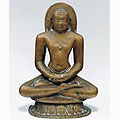 |
|
 |
 |
 |
 |
 |
 |
 |
 |
Jain sculpture
Jainism is a religious faith that stresses nonviolence toward all living things and the practice of austerities. It has been practiced in India since at least the 6th century B.C.E., if not earlier, and currently has a following of about six million people. The term Jainism is derived from jina ("conqueror" or "liberator"), the name given to the twenty-four principal adepts and teachers of this religion. These figures, also known as tirthankaras or "river-forders," are the principal focus of Jain art. The highest ideal in Jainism is the wandering, possessionless, and passionless ascetic, which is why jinas are always depicted as mendicants or yogis. They are portrayed in only two positions: either seated in the lotus posture (padmasana) or standing in the exclusively Jain body-abandonment posture (kayotsarga). The nakedness of the two jina images in the Asia Society's collection indicates that they belong to the Digambara or "sky-clad" sect of Jainism, which is the more austere of the two primary branches of this religion. |
 |
 |
| 1 thru 2 of 2 |
 |
| view text only list |
 |

Tirthankara |
 |

Tirthankara |
 |
|
 |